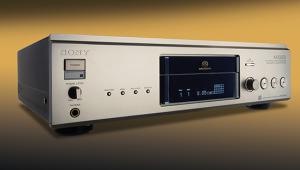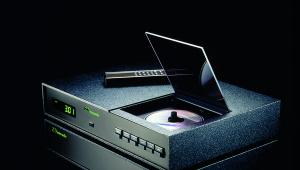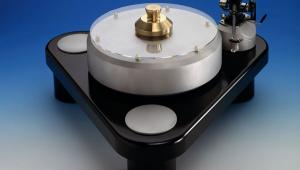Samuel Johnson Audio

 The arrival of a new British hi-fi brand is a major event. Ivor Humphreys hears Samuel Johnson's 50W-rated pca100/ppa100 pre/power amplifiers
The arrival of a new British hi-fi brand is a major event. Ivor Humphreys hears Samuel Johnson's 50W-rated pca100/ppa100 pre/power amplifiers
Abrand new company, Samuel Johnson was founded by a group of enthusiasts, most of whom had met through their work with a Scottish-based manufacturer of control systems for industrial applications and who discovered further common ground in a consuming interest in hi-fi.
With an established background in the design and manufacture of precision electronics, the team has enjoyed something of a headstart in the new venture. Much of the groundwork had already been done, proven either through those aspects it has in common with sophisticated control circuitry (power supplies, for example) or through gradual development over the years on the designer's private workbench. An immeasurable additional advantage was that so many of the component sourcing, board and fabrication issues were already resolved.

Samuel Johnson Audio is based in Prestwick, Scotland. The company, like its name, displays healthy cross-border links since its designer, Norman Johnson, is English, like his 18th-century namesake, while many of his colleagues are Scots, like the great lexicographer's friend and biographer, James Boswell. But one shouldn't make too much of these things! SJ needs no historical prop.
Curve Ball
Certainly if looks and build quality are arbiters of success, SJ should find itself stretched to meet demand, for the styling and attention to detail evident here is exceptional. There are three products initially in what is termed the Premium range: a pre/power amplifier combination and a DAC, while a CD transport is said to be nearing completion. Here we look at the pre/power coupling.
The 360mm midi-width cabinets are available in a choice of finishes. The review samples, pictured here, were in a light champagne gold, but chrome-like polished aluminium, black and graphite are other current options. The covers have a textured paint coating while the fascias present a striking combination of anodised aluminium and real wood – a choice of rosewood, ash, American walnut, cherry, mahogany or walnut.
These fascias must have presented a major challenge in their precision marrying of curved sections of such dissimilar materials. Points of subtle detail abound. For example, the control buttons sit in recesses whose curved profile is a miniature concave echo of the palm-sized handset's elliptical profile. The company logo is subtle too, set only within the large standby button.

pca100 Preamplifier
The pca100 preamplifier, or control amplifier as SJ terms it, is unashamedly minimalist in its function, offering no balance or tone controls or filters, despite its unusually high component count, much of which concerns the highly elaborate power supply arrangements. As standard there are six unbalanced line-level inputs, all electrically identical, presenting a 47kohm input impedance and a sensitivity of 360mV for 1V output at full gain.
An optional phono input will be available, but at the time of writing this was not yet finalised. It seems likely that there will be a choice of modules to suit MC or MM and high-output MC cartridges. The line inputs are labelled CD, Tuner, Aux 1 and 2 and Tape 1 and 2, and there are separate recording outputs to allow active off-tape monitoring and/or dubbing with three-head recorders. Separate 'listen' and 'record-out' selectors allow one source to be recorded while another is heard.

The SJ components are normally left powered on and brought in and out of standby by the large button on the fascia. An adjacent small LED glows orange in standby, and green when the circuit is ready. Five small buttons activate logic circuitry to control input and record output selection, volume up/down and mute. Input/record output status is indicated by two labelled rows of six blue LEDs and the mute condition by a single red LED. All these functions (apart from standby) are also available on the remote control handset [see p131], which manages with just four buttons.
On The Boards
The rear panel of the pca100 sports a fused three-pin IEC mains socket with an integral rocker switch (that is normally left on), 13 pairs of gold-plated RCA phono sockets and a 6.35mm headphones output. Why so many phonos? Well, two are in place ready for the optional RIAA board, but there are four more pairs connected in parallel and allocated to the main preamp output, facilitating bi-, tri or even quad-amplification should this be required.
As mentioned, the component count is high. The circuit is built on three printed circuit boards, one each for the power supply, front panel switching/logic/display, and for the main audio circuit. I don't recall seeing such an elaborate power supply in a preamplifier. An EMC filter follows the IEC input to minimise mains-borne interference and this is followed by no fewer than six (wonderfully silent) transformers. Four of these are custom-wound, canned/screened toroids, providing independent supplies for the input and output stages of each channel.

Extreme Measures
Each transformer feeds its own bridge rectifier, a pair of 6800pF reservoir capacitors and monolithic voltage regulators to provide the ±15V DC feed to the audio board, with local decoupling around each active device. The fifth transformer feeds the control logic, display board and motorised volume control, while the sixth, smaller one, is devoted to the signal switching relays.
Many would consider this an altogether extreme set-up for a preamp, but Johnson is convinced that signal integrity depends upon maximum stability of the low-voltage DC supply lines, on near-zero crosstalk between stages and channels, and on the lowest possible noise floor throughout.
Another key aspect is a short signal path and to this end all the relevant circuitry is located adjacent to the rear panel, with the switching handled locally by an array of 12 Meisei encapsulated relays. Separate amplifier stages are employed for the main and headphones outputs and the tape output is properly buffered (for once).
























































